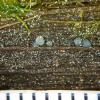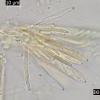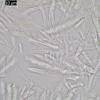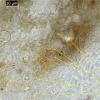
05-08-2024 08:26
 Lothar Krieglsteiner
Lothar Krieglsteiner
French Alps, 13.7.24, on twig of either Alnus alno

09-08-2024 08:22
Andreas LoosliHello Everybody, my Name is Andyi am new here in

11-08-2024 10:28
Henri KoskinenOrange apothecia 2-8 mm, on sandy roadside soil am

13-08-2024 17:20
 Lothar Krieglsteiner
Lothar Krieglsteiner
.. a collection from 19.3.2008, Hessen, Germany, o

04-08-2024 19:30
 Lothar Krieglsteiner
Lothar Krieglsteiner
French Alps, on Corylus, together with Orbilia tra

22-04-2024 20:38
 Miguel Ángel Ribes
Miguel Ángel Ribes
Good afternoon.Does anyone know this anamorph?It g

12-08-2024 09:28
 Miguel Ángel Ribes
Miguel Ángel Ribes
Good morning This small (about 1 mm wide), stalke

05-08-2024 14:32
 Miguel Ángel Ribes
Miguel Ángel Ribes
Good morning This orange-brown Ciboria or Moeller
I found the following small Mollisia on 25.08.2024 on 'last year's' Typha at the edge of a pond.
The growth point was at the base of the stem lying in the water.
Steinbach, MTB 6507,23, approx. 400m altitude.
Diameter of the apothecia approx. 0.6 to 0.8mm,
Apices pulvinate when young, later flattened. Grey-blue to grey-brown, sometimes with lighter centre.
Asci approx. 64 x 7 ym, hooks +,difficult to recognise.
Porus reaction +bb
Paraphylls with refractive vacuoles KOH-
Marginal cells variously shaped, expiculum cells spherical
Spores OCI 2- 3, club-shaped
Spores [95% - 23 - QPr - v - H2O(nat) ] = 9.2 - 11 - 12.7 x 1.9 - 2.6 - 3.3 µm;
lav x bav = 11 ±0.36 x 2.6 ±0.13 µm, Qav = 4.2 ±0.18
According to the key from Ingo Wagner I ended up with 'Mollisia poaeoides Rehm 1891'.
What is your opinion?
Many thanks in advance
Best regards
Dirk

I would have taken a wrong turn here with the key
1120 not on Phragmitis (reed) --> 1130
1120* on Phragmitis (reed) --> Mollisia hydrophila
Spores 9-12(15?) x 2-2.6, KOH- or KOH+
But I have crushed a whole apo here and if that passes as crystals? OK
I looked in your folder and can't really imagine what crystals are there, sorry.
Best regards
Dirk


thank you very much for your support and opinion.
Then I will file the find under Mollisia_cf. hydrophylla KOH-, few to no crystals.
Herzliche Grüße
Dirk

With clavate spores with OCI = 2 and KOH-negative reaction compare also with "Mollisia tomentosa":
https://drive.google.com/drive/u/0/folders/11dtcLhIyx8rbRjAJv_gdhMM-vz3YT5fn?tid=0B5SeyOEkxxZhYVZub0N1aGY5YTg
Greetings
Ingo

Hi Ingo,
Thank you very much for your information.
The picture 'Mollisia hydrophila 19.IX.2017-2 in the folder fits almost exactly to the micro features I have noticed.
In Ekanayaka's description, however, the asci are described as being significantly longer than mine were.
Here are three examples of my measurements: 64x6.5; 60 x 5.7, 65 x6.5 ym
I also saw the pulvinate very well, which I had not noticed in 'my' previous Mollisia finds.
Could well have something to do with the location under water, as it was no longer visible later (one or two) days later.
Thank you and best regards
Dirk

Dirk:
"In Ekanayaka's description, however, the asci are described as being significantly longer than mine were.
Here are three examples of my measurements: 64x6.5; 60 x 5.7, 65 x6.5 ym"
It is important in which state you measure the asci, keyword turgor.
https://asco-sonneberg.de/pages/gallery/ascus-turgor40991.php?group_id=29201&position=2
Greetings
Ingo











